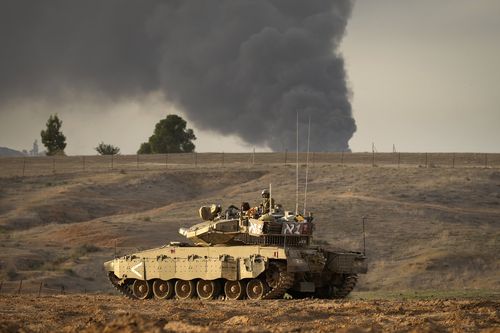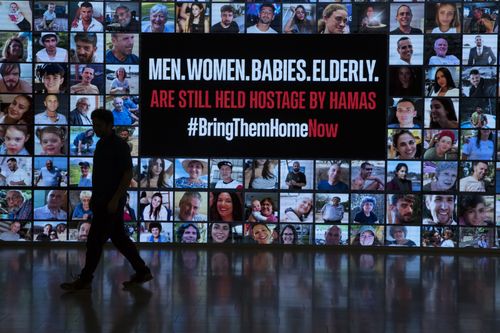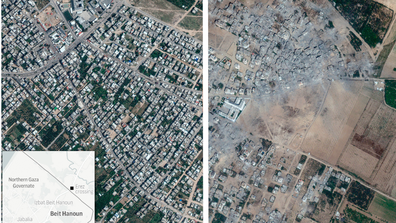US officials have a working list of 10 hostages that they believe are likely to be released from Gaza on day one, a source familiar told CNN.
It was not clear whether any of the three American hostages —including three-year-old Abigail Edan — would be released on the first day.
The working list consists of 10 individuals who Hamas had proposed releasing earlier in the negotiations. The list consists of information such as gender, nationality and age, but the names of the individuals were never offered.
The deal is structured in such a way that each day, a group of hostages to be released would be handed off to the Red Cross; the Red Cross would then take the group to a designated border point, which will largely depend on the location of those hostages, the source familiar said. Many of the first 50 hostages are expected to come out through Egypt, they said.
A source familiar with how hostages are expected to leave Gaza told CNN that the first swap had been expected to take place on Thursday (Friday AEDT). However, the Israeli National Security Council said later that the pause would be delayed and no hostages are expected to be released before the weekend.
“Talks to release our hostages are advancing and are ongoing. The start of the release process will take place according to the original agreement between both sides, and not before Friday,” Israel’s National Security Council said in a statement.
Fifty Israel hostages — including some with dual nationalities — are expected to be released over the four-day pause. The minimum number of hostages to be released every day is 10, but that could be higher.

Every evening before the next day’s release Israel and Hamas will give the Red Cross the list of hostage and prisoner names being released.
Hostages will be brought by the Red Cross to Rafah where they will be met by specially trained Israeli soldiers. They will verify that the hostages released were the people expected and on the list. The families of the hostages will not be notified until the identities of those released have been confirmed.
Hostages will then be taken by helicopter to several designated hospitals in Israel where there will be special areas and rooms for them, closed to the public. There, their families will finally be able to see them after more than six weeks in captivity.
The first two days of the hostage release will be treated as a “testing period,” the source said, to make sure the process is working. By day three, there is expected to be intense discussions about the potential second phase of the hostage release beyond the initial group of 50.
“The first swap is the most crucial to see that the mechanism is working as was agreed,” the source said.

In terms of the remaining hostages, including Israeli soldiers, Hamas had initially tried to designate all Israeli women under 45 as soldiers, given that women have to serve in the Israeli military and are often reservists, the source said.
Israel rejected that, and the two sides agreed that only women serving, in uniform when they were abducted, would be designated as soldiers.
As part of the deal the Red Cross is expected to be able to visit and offer medical support to the hostages that remain in Gaza, the source said.
White House Coordinator for the Middle East and North Africa Brett McGurk told CNN he could not speak to the schedule of when the Americans would be released.
He confirmed that three US hostages – Edan and two women — are expected to come home as part of the 50 hostages released by Hamas. A total of 10 Americans are believed to be hostages.
“I was asked earlier do we know if the 50 are alive and well. We understand they’re alive, but they’re certainly not well,” McGurk said. “These 50 women, children and toddlers, it’s just unimaginable what they’ve gone through, but we’re gonna make sure that they get the care they need when they come home.”
McGurk said he is “hopeful” that the Red Cross will get access to the other hostages but noted, “I cannot confirm that nor guarantee that.”
McGurk suggested that the humanitarian pause and hostage releases could continue beyond the initial four-day period, saying they “do have some assurances” on this.
“For this humanitarian pause to continue, we have to see more hostages coming out,” he said. “We do have some assurance that even beyond the four-day period, on day five, day six, we will meet that benchmark to extend the humanitarian pause at least by those of period of days, but I can’t guarantee that.”
“We have to see and again, we’re dealing with Hamas, a terrorist group here, who’s holding toddlers and babies at the other end of the table,” he said.
Meanwhile, the Israeli Supreme Court “has now greenlit the (hostage) deal to go forward,” thus clearing the way for the process to move forward this week, McGurk said.
A senior Israeli official told CNN on Tuesday that there was a 24-hour window following the announcement of the deal for appeals to be lodged with the court.
The Supreme Court has rejected a legal challenge to the Gaza hostage deal, which includes the release of at least 150 Palestinian prisoners held in Israeli jails.
The Almagor association, which was set up in 1986 to represent victims of terror, had claimed that the government’s decision, among a series of objections, intensified the risk of “the recurrence of serious acts of terrorism to which all the citizens and residents of the country are exposed.”
Almagor had asked the Supreme Court to “annul the government’s decision … [and] order [the government] to discuss again the terms of the deal with Hamas,” according to information released by the court.
The court said it rejected the petition outright on the grounds that the hostage deal, “is a clear political issue to which this court does not consider its involvement as necessary.”
The ruling clears any legal objection in Israel to the execution of the deal that involves the exchange of Israeli hostages in Gaza for the release of Palestinian prisoners in Israeli jails.

